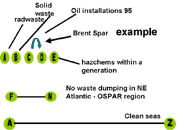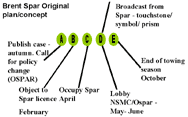campaignstrategy.org
modest suggestions for anyone trying to save the world
» 12 basic guidelines: Construct a critical path

All issues are complex but your campaign must not be.
Issues are like fractals - cut them down and they are still as complex as the 'big picture'. Get down to real detail and the politics of your town, village or street are as byzantine as those of the UN Security Council. That is no excuse for communicating complexity.
Complexity demotivates, it makes people feel confused - and if they feel confused, they will think you are confused, and not worth listening to.
In German there is an expression 'the red thread' - meaning the important line that runs through a complex picture, place or process. Your campaign has to be like a red thread. It cannot be the 'whole picture'. Instead it has to be a way, a trail, stepping stones, a critical-path. Do not try to communicate 'the issue', however tempting it may be. Communicate your campaign - what you think, the problem as you see it, the solution as you see it, the opportunity as you see it - and only that.
Stick at each stage until it is achieved. Each stage is a target or objective in itself. For example you may need to get a critical level of awareness about the existence of a problem, or the buy-in of a certain number of decision-makers, before you can move on. Resist the temptation to talk ahead by giving 'the whole picture'.
Plan a campaign as a series of steps where one leads to the next - like dominoes. Critical paths can be planned at several levels - for instance at the level of a campaign's mission, at a campaign planning level and at a project level.

Here is the example of the Brent Spar campaign by Greenpeace. The long-term mission level campaign was 'clean seas'. Within that, Greenpeace singled out the North East Atlantic pollution control treaty (OSPAR - Oslo and Paris Commission) as a political focus through which it could set an example about responsible use of the oceans.

The organisation closed off one waste-dumping route after another, starting with radioactive waste then solid wastes, oil installations and now hazardous chemicals. In the mid 1990s it was faced with a 'loophole' allowing the oil industry to dump its installations - for which the Brent Spar was to be a precedent. Hence the logic of the campaign.
At a project level the strategy was to occupy the redundant installation for the duration of the 'towing season', during which it was anticipated that communications and political work would allow the campaign to secure a reversal of the dumping decision. (As it happened the campaign took a different and successful course with a reversal on June 20).

"A handful of chaps on a lilo taking on the entire Western economy - and with it the biggest piece of litter in the world... an incident crammed with dramatic polarities and symbolism of the most unsubtle kind" - Simon Barnes, Journalist
Try mapping out the forces for and against what you want to happen. Draw a map of the problem - the people involved, the organisations, the institutions - work out exactly what the mechanisms are for the decisions you want to change.